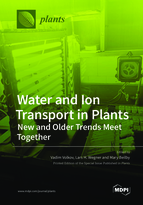Water and Ion Transport in Plants: New and Older Trends Meet Together
A special issue of Plants (ISSN 2223-7747). This special issue belongs to the section "Plant Cell Biology".
Deadline for manuscript submissions: closed (30 September 2021) | Viewed by 16528
Special Issue Editors
Interests: water and ion transport; membrane transport; halophytes; electrophysiology; biophysics; visual perception
Special Issues, Collections and Topics in MDPI journals
Interests: plant water relations; plant nutrition; ion transport; electrophysiology; biophysics; systems biology
Interests: biophysics; electrophysiology (plant cells); ion transporters; salt tolerance and sensitivity; action potential (plants); circadian rhythms; data-logging and experimental computer control; teaching techniques
Special Issues, Collections and Topics in MDPI journals
Special Issue Information
Dear Colleagues,
The transport of water and ions underlies all organized fluxes in plants, fluxes that secure homeostasis and provide the matrix for biochemical reactions, orchestrated cellular events, and development. At the cellular level, water and ions pass via cell membranes using a set of aquaporins as well as specific ion channels and transporters; transport follows thermodynamic and electrochemical gradients. At the whole-plant level, specialized tissues such as xylem and phloem have evolved to transport ions and water from roots to shoots and metabolites in the reverse direction. At the level of the ecosystem and for agricultural productivity, supply and transport of water and ions form the basis for crop yield. All the processes for this exceptionally wide topic cannot be covered within a single Special Issue, so our aim is to recall the main concepts established for water and ion transport, to introduce new ideas, including controversial ones, and to link these ides to generate directions of potential research and progress.
Dr. Vadim Volkov
Prof. Lars H. Wegner
Dr. Mary Beilby
Guest Editors
Manuscript Submission Information
Manuscripts should be submitted online at www.mdpi.com by registering and logging in to this website. Once you are registered, click here to go to the submission form. Manuscripts can be submitted until the deadline. All submissions that pass pre-check are peer-reviewed. Accepted papers will be published continuously in the journal (as soon as accepted) and will be listed together on the special issue website. Research articles, review articles as well as short communications are invited. For planned papers, a title and short abstract (about 100 words) can be sent to the Editorial Office for announcement on this website.
Submitted manuscripts should not have been published previously, nor be under consideration for publication elsewhere (except conference proceedings papers). All manuscripts are thoroughly refereed through a single-blind peer-review process. A guide for authors and other relevant information for submission of manuscripts is available on the Instructions for Authors page. Plants is an international peer-reviewed open access semimonthly journal published by MDPI.
Please visit the Instructions for Authors page before submitting a manuscript. The Article Processing Charge (APC) for publication in this open access journal is 2700 CHF (Swiss Francs). Submitted papers should be well formatted and use good English. Authors may use MDPI's English editing service prior to publication or during author revisions.
Keywords
- water transport
- ion transport
- water and ion fluxes in plants
- ion channels
- ion transporters
- aquaporins







